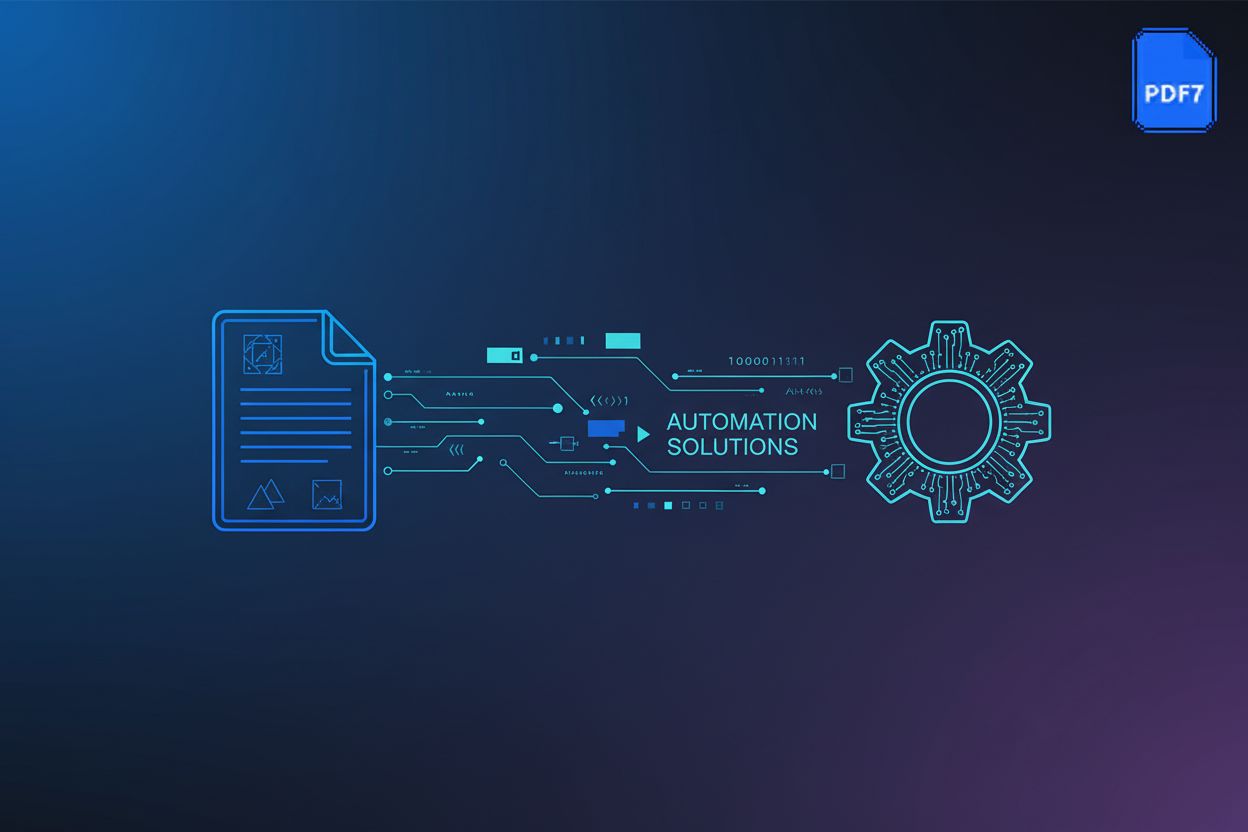API Solutions for Extracting, Editing, and Converting PDF Files
TL;DR
Introduction to PDF APIs: Why Use Them?
Isn't it crazy how much of our lives are trapped inside PDFs? Think about it! So, what if you could just, like, easily grab that data, tweak it, or turn it into something else entirely? That's where PDF APIs come in – and trust me, they're a game-changer.
An API, or Application Programming Interface, in this context, is essentially a set of rules and tools that lets different software applications talk to each other. For PDF manipulation, it means your program can instruct a PDF API to perform actions like extracting text, editing content, or converting formats, without you having to manually open and interact with the PDF yourself.
We're drowning in digital documents, aren't we? And it's not just about having more files. It's the need to actually do things with them automatically. Imagine sifting through hundreds of invoices, or contracts, manually. No thanks! Lots of companies are realizing they need to automate data extraction, automate document editing, and automate document conversion, you know?
- The rise in digital document usage has made it essential to automate PDF workflows, so you don't have to waste time doing it manually. Manual processing is time-consuming and prone to errors because PDFs have a fixed layout and aren't inherently structured for easy data extraction or modification.
- PDF apis are here to help you automate stuff, so you can focus on more important things.
- The old way of doing things, where you manually process PDFs, it's not cutting it anymore.
Okay, so why use an api instead of, say, just doing everything by hand? Well, for starters...
- It's way faster and more efficient. Like, way faster. Think about automatically extracting data from thousands of documents instead of one at a time.
- They're scalable, so whether you're a small business or a big enterprise, APIs can handle the load. Plus, they're super reliable.
- you can seamlessly integrate them into your existing systems. It's like adding a super-powered engine to what you're already using.
- And let's be real, it saves money! Less manual labor means lower costs.
PDF APIs aren't just for one type of business. Everyone's using them!
- Law firms use them for processing legal documents.
- Finance companies generate reports.
- Schools manage educational stuff.
- Even hospitals keep track of records using these tools. It's pretty wild, honestly.
So, what's next? We'll be diving into the specifics of extracting data from PDFs using apis – get ready to see how it all works! We'll also cover editing and converting PDFs, so you get the full picture.
Key Functionalities: Extracting Data from PDFs
Okay, so you've got this pdf, right? But what if you need the actual stuff inside? That's where extraction comes in – and it's way more interesting than it sounds.
Think of all the information locked away in those files. It's like a digital treasure hunt!
- Unlocking Hidden Insights: Businesses can extract data from invoices, receipts, and reports to identify trends, optimize spending, and make informed decisions. You know, instead of just guessing.
- Automating Workflows: Imagine automatically pulling data from contracts to update CRM systems, or extracting product details from catalogs to populate an e-commerce website. Talk about saving time!
- Improving Data Accessibility: Extracting data allows you to convert it into more accessible formats like CSV or JSON, making it easier to analyze and share. 'Cause nobody wants to be stuck with just a PDF.
- Enhancing Decision Making: Data extraction is critical for informed decision-making, streamlining operations, and gaining a competitive edge.
It's not magic, but it kinda feels like it sometimes.
- Text Extraction: This is the most basic form, where the API pulls out all the text from the PDF. But it's not always perfect; scanned documents can be tricky. Scanned documents are tricky because they are essentially images of text, not actual text data. To extract text from them, Optical Character Recognition (OCR) technology is needed. The accuracy of OCR can be affected by factors like the quality of the scan (blurry or low-resolution images), unusual fonts, or complex layouts.
- Image Extraction: Need the logos or photos from a PDF? This extracts those images while trying to keep the quality as high as possible.
- Table Extraction: This is where things get interesting. APIs can identify tables within a PDF and convert them into usable data formats like CSV or Excel. It's really useful for Finance! For example, extracting financial statements, invoices, or balance sheets becomes much simpler.
Data extraction is useful across many industries.
- Healthcare: Hospitals can extract patient data from medical records to improve care coordination and reporting.
- Retail: E-commerce companies can extract product information from supplier catalogs to update their online stores.
- Finance: Financial institutions can extract data from loan applications to automate the approval process.
So, you've extracted the data – what next? Well, we'll be looking at how to make this data usable.
Editing PDF Content Programmatically
Okay, so you've ripped the data out of your PDFs, now what? Time to get your hands dirty and actually change stuff, right? Editing PDF content programmatically lets you do just that, and it's way cool.
One of the most basic things you can do is mess with the text. Sounds simple, but there's a lot to it.
- Text placement and formatting is key. You can't just slap text anywhere; you need to control where it goes and how it looks. Think about font size, color, alignment—all that jazz. For example, a marketing company might automatically update the expiration date on thousands of promotional flyers.
- Font management is another hurdle. Not all PDFs use the same fonts, and you need to make sure your API can handle different typefaces. Plus, embedding fonts ensures your edits look right no matter where the PDF is opened. This is necessary because if the recipient's system doesn't have the font installed, the PDF might display incorrectly or with a substitute font.
- Handling different character encodings is crucial if you're dealing with multiple languages. APIs need to support UTF-8 and other encodings to avoid garbled text. Imagine a global logistics company needing to update shipping addresses in various languages – that's where this becomes essential. Using UTF-8 is particularly important as it can represent virtually any character from any language, making it ideal for internationalization.
Text isn't the only thing you can tweak; images are fair game too.
- Image positioning and layering lets you control where images appear in relation to other elements. Want a logo in the top-right corner? No problem. Layering is important too, so images don't cover up important text.
- Image compression options help you balance quality and file size. Nobody wants a huge PDF because of a single high-res image. APIs often let you choose different compression algorithms to optimize the file.
- Maintaining aspect ratio is vital to prevent images from looking stretched or squashed. A real estate company, for instance, would want to ensure property photos look their best when programmatically adding them to brochures.
Want to leave your mark? Annotations, watermarks, and signatures are the way to go.
- Types of annotations are varied – comments, highlights, underlines, you name it. These are great for collaboration and feedback. Law firms, for example, might use annotations extensively when reviewing legal documents.
- Watermark placement and transparency are important for branding and security. A watermark can prevent unauthorized use of a document, and transparency ensures it doesn't obscure the content.
- Digital signature integration adds a layer of security and authenticity. This is especially important for contracts and other legal documents. Think about banks needing to digitally sign financial statements automatically.
So, you've edited your PDF. Now, how about converting it to a completely different format? We'll dive into that next.
Converting PDFs to Other Formats (and Vice Versa)
Okay, so you've massaged your PDF into the perfect shape... but what if you need it as a Word doc? Or an image? That's where converting comes in, and it's more than just a simple "save as."
Converting PDFs to Word (.docx) might seem straightforward, but it's actually kinda tricky. You want to keep all the formatting, right?
- One of the biggest challenges is maintaining the original layout. PDFs are designed to be fixed, while Word documents are, well, flowy. APIs need to be smart about how they translate things like columns, tables, and images. They do this by analyzing the PDF's structure, identifying elements like text blocks, images, and tables, and then reconstructing them in a Word-compatible format. Common pitfalls include misinterpreting complex layouts, losing formatting, or incorrectly converting tables.
- Then there's preserving fonts and styles. If your PDF uses some fancy-pants font that Word doesn't have, the API needs to either embed the font or find a suitable substitute. Otherwise, things can look real wonky.
- Handling tables and images can be a nightmare. APIs need to accurately identify tables and convert them into editable Word tables. Plus, images need to be placed correctly and maintain their quality.
Sometimes you don't need editable text; you just need a picture. Converting PDFs to images opens up a whole new world of possibilities.
- Choosing the right image format is key. JPEG is great for photos because it uses lossy compression, resulting in smaller file sizes, but can degrade quality. PNG is better for graphics with sharp lines and text because it uses lossless compression, preserving quality but resulting in larger files. TIFF is often used for archiving because it's lossless and supports multiple pages, but files can be very large.
- Setting the right image resolution is also important. Higher resolution means better quality, but also larger file sizes. You need to find the sweet spot. Like, if you're just using the image for a website thumbnail, you don't need a super high resolution.
- Batch conversion options can save you a ton of time. Instead of converting each PDF individually, you can convert a whole folder at once.
But wait, there's more! PDF APIs can convert to all sorts of other formats too.
- PDF to Excel conversion can be super useful for extracting tabular data. The API needs to accurately identify rows and columns and convert them into a usable spreadsheet.
- PDF to HTML conversion is great for displaying PDFs on the web. The API needs to convert the PDF content into HTML elements while maintaining the original layout and formatting.
- And then there's all sorts of other file formats like txt, rtf, and even xml. The possibilities are endless! For instance, converting to TXT is useful for simple text extraction when formatting isn't important, and converting to XML can be valuable for creating structured data that can be easily processed by other applications.
Converting PDFs opens up a lot of doors. Next up, we'll look at choosing the right API for your needs.
Choosing the Right PDF API: Factors to Consider
So, you're ready to pick a PDF api, huh? It's kinda like choosing a car – you gotta figure out what you actually need it to do.
- Required features is kinda the most important thing, right? Don't get distracted by bells and whistles if you only need basic text extraction. Think about what your core use case is. For instance, if you're in healthcare, you'll need an API that can handle the specific formatting of medical records.
- Scalability and performance are also super important. Will this API choke when you throw thousands of documents at it? You want something that can grow with you. A small startup might be fine with a basic API to start, but a large financial institution will need something way more robust.
- Integration capabilities can be a make-or-break thing. How well does the API work with your existing software infrastructure, programming languages, and frameworks? If you're using a specific CRM or document management platform, you'll want an API that integrates seamlessly. Otherwise, you're just creating more work for yourself.
- Pricing and Licensing: Understand the cost structure. Is it per-API call, subscription-based, or a one-time fee? What are the licensing terms for commercial use?
- Security: How does the API handle sensitive data? Look for features like encryption, secure connections, and data privacy policies.
- Support: What kind of technical support is available? Is there a community forum, documentation, or direct support channels?
- Ease of Use and Documentation: How easy is it to get started? Is the documentation clear, comprehensive, and up-to-date?
Don't just jump at the first shiny thing you see, you know?
Next up, we'll get into the code examples, because seeing is believing.
Code Examples: Integrating PDF APIs into Your Applications
Okay, so you're sold on PDF APIs, but how do you actually use them? Let's get real, seeing code in action is way more convincing than just hearing about it.
Python's a go-to for a lot of things, and PDF manipulation is no exception. You'll need a library, of course. There's a bunch out there, but pdfminer.six is a solid choice. To use it, you'd install it with pip: pip install pdfminer.six.
Now, here's a super-simplified snippet to get you started:
from pdfminer.high_level import extract_text
pdf_path = 'your_pdf_file.pdf'
try:
text = extract_text(pdf_path)
print(text)
except FileNotFoundError:
print(f"Error: The file '{pdf_path}' was not found.")
except Exception as e:
print(f"An unexpected error occurred: {e}")
It's deceptively simple, right? But remember, error handling is key. What if the file doesn't exist? Or is corrupted? Wrap that in a try...except block, trust me.
Okay, switching gears to JavaScript. For converting PDFs to images in the browser, you might wanna look at pdf.js from Mozilla. It's pretty powerful, though can be a little tricky to set up initially.
Here's a basic example using it, but keep in mind, this is client-side, so you'll need an HTML setup:
pdfjsLib.getDocument('your_pdf_file.pdf')
.promise.then(function(pdf) {
return pdf.getPage(1);
})
.then(function(page) {
// You will need to render the page to a canvas here
// This is a simplified version
const canvas = document.getElementById('pdf-canvas'); // Assuming you have a canvas element with this ID
const context = canvas.getContext('2d');
const viewport = page.getViewport({ scale: 1.5 }); // Example scale
canvas.height = viewport.height;
canvas.width = viewport.width;
const renderContext = {
canvasContext: context,
viewport: viewport
};
page.render(renderContext);
console.log('Page rendered');
})
.catch(function(error) {
console.error('Error loading PDF:', error);
});
Configuration options are important here. Think about the scale of the rendering, the image quality, stuff like that. It's gonna depend on what you're using the images for. You can find more details on configuration options in the pdf.js documentation.
C# is often used in enterprise environments, and there's some pretty robust PDF API options. itext7 is a popular library, but it's worth noting that licensing can be a consideration depending on your use case.
Here's a snippet to add text to an existing PDF:
using iText.Kernel.Pdf;
using iText.Kernel.Pdf.Canvas.Draw;
using iText.Layout;
using iText.Layout.Element;
// ... (rest of your code)
string filePath = "your_pdf_file.pdf";
string outputPath = "output.pdf";
using (PdfDocument pdfDoc = new PdfDocument(new PdfReader(filePath), new PdfWriter(outputPath)))
{
Document doc = new Document(pdfDoc);
doc.Add(new Paragraph("Hello, world!"));
// No explicit Close() needed here because of the 'using' statement
} // pdfDoc and doc are automatically disposed of here
One common pitfall? Not disposing of objects properly. PDF libraries often handle resources, so make sure you're using using statements or explicitly closing streams.
So, there you have it – a glimpse into how to integrate PDF APIs into your applications with different languages. Next, we'll wrap things up.
Conclusion: Streamlining Document Workflows with PDF APIs
So, you've made it to the end – congrats! But are you really using PDFs to their full potential? Probably not, right?
- Efficiency Boost: PDF APIs seriously cut down on manual labor. Think about banks automatically processing loan applications instead of someone, y'know, actually typing everything.
- Cost Savings: Less time wrestling with documents means less money spent. Like, a retail company could save a ton by automating product catalog updates and not paying someone to do it manually.
- Automation Awesomeness: PDF APIs let you hook into other systems, so data flows smoothly. A hospital, for example, can automatically update patient records, which streamlines everything.
And hey, the future's looking bright, with AI and cloud stuff making these tools even cooler. For instance, AI is enabling more intelligent data extraction from complex documents, and cloud-based processing offers enhanced scalability and accessibility. Get ready for more cool stuff, basically.









